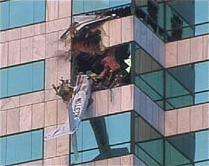2002 Tampa Cessna 172 crash
 The plane's tail hangs from the Bank of America building in Tampa, Florida. | |
| Date | January 5, 2002 |
|---|---|
| Summary | Aircraft theft and suicide by pilot |
| Site |
Tampa, Florida, U.S. Coordinates: 27°56′49″N 82°27′33″W / 27.947°N 82.45928°W |
| Aircraft | |
| Aircraft type | Cessna 172 |
| Operator | Privately owned |
| Registration | N2371N |
| Passengers | 0 |
| Crew | 1 |
| Fatalities | 1 |
| Survivors | 0 |
On January 5, 2002, Charles J. Bishop, a high-school student of East Lake High School in Tarpon Springs, Florida, United States, stole a Cessna 172 light aircraft and crashed it into the side of the Bank of America Tower in downtown Tampa, Florida. The impact killed the teenager and damaged an office room, but there were no other injuries.
Bishop had been inspired by the September 11 attacks; he had left a suicide note crediting Osama bin Laden for the attacks and praising it as a justified response to actions against the Palestinians and Iraqis, and said he (Bishop) was acting on behalf of Al Qaeda, from whom he'd turned down help. As officials could find no evidence of any connections, terrorism as a motive was ruled out, and they suggested that the crash was an apparent suicide. Bishop's mother filed, then dropped, a lawsuit claiming that an acne medicine Bishop took, isotretinoin, had side effects such as depression and suicidal actions, and caused the incident.
Incident
At 5:00 pm EST, 15-year-old Charlie J. Bishop's instructor left him at the plane to perform a preflight inspection. Once he was left alone in the plane, he started the engine and took off without permission.[1] As soon as the plane took off, the air traffic controllers alerted the United States Coast Guard and the MacDill Air Force Base. Despite repeated warnings from a helicopter dispatched by the Coast Guard, the small plane continued on until it collided with an office building. The plane crashed between the 28th and 29th floors of the 42-story building.[1][2]
Pilot
Bishop was a 15-year-old high-school student from Tarpon Springs, Florida. At the time of the incident, he was a student pilot and only authorized to fly with a Certified Flight Instructor.
Investigation and aftermath
An investigation followed the incident. Officials ruled out terrorism although eyewitnesses said that the plane made no apparent attempt to avoid hitting the building. Officials finally suggested that the crash was an apparent suicide. In addition, a note found in the wreckage stated that he voiced support for Osama bin Laden. However, there is no evidence that the teen had any connection with any terror group. The suicide note found in the pocket of the pilot stated:
I have prepared this statement in regards to the acts I am about to commit. First of all, Osama bin Laden is absolutely justified in the terror he has caused on 9-11. He has brought a mighty nation to its knees! God blesses him and the others who helped make September 11th happen. The U.S. will have to face the consequences for its horrific actions against the Palestinian people and Iraqis by its allegiance with the monstrous Israelis--who want nothing short of world domination! You will pay--God help you--and I will make you pay! There will be more coming! Al Qaeda and other organizations have met with me several times to discuss the option of me joining. I didn't. This is an operation done by me only. I had no other help, although, I am acting on their behalf.
Later authorities confiscated a computer from Bishop's parents' house to try to determine a motive for the incident. Moments after the incident, President George W. Bush was briefly informed about the incident and two unrelated crashes that same day.[1]
In April 2002, transcripts obtained from the Federal Aviation Administration revealed new details about the incident, which included how close the small plane came to a Southwest Airlines flight.[3]
Bishop's mother filed a $70 million (2002 USD) lawsuit against Roche Laboratories, who makes an acne medicine called Accutane. According to the lawsuit claim the medicine had side effects such as depression and suicidal actions, which the claim stated as the cause of the incident.[4] The suit was dropped on June 26, 2007, by Bishop's mother, who stated she was physically and emotionally unable to continue the action.[5]
After the incident took place, numerous security measures were taken. The FAA released a security notice on January 6, the day after the incident. The notice included security of the aircraft and regulations pertaining to underaged flight students. In addition, the EAA and other smaller aircraft organizations proposed more security of flight schools and small aircraft.[6][7]
While authorities stated that the crash was due to an "abuse of trust" rather than a security breach, others argue for the need of increased security due to the simplicity of such actions.[8]
See also
References
- 1 2 3 "Police: Tampa pilot voiced support for bin Laden", "CNN", 2002-01-07. URL Accessed: November 15, 2014.
- ↑ "Small, stolen plane slams into Tampa skyscraper" Archived 2005-11-27 at the Wayback Machine., CNN, 2002-01-05. URL Accessed: August 12, 2006
- ↑ Adair, Bill (April 23, 2002). "Cessna 'real close' to airliner". St. Petersburg Times. Retrieved 2006-08-04.
- ↑ Unknown Plane Crash Aftermath URL Accessed: July 28, 2006
- ↑ "Lawsuit ends over boy-pilot's acne drug". Archived from the original on 27 September 2007. Retrieved 2007-10-07.
- ↑ EAA (2002) FAA RELEASES SECURITY NOTICE FOR FBOS AND FLIGHT SCHOOLS Archived 2006-10-05 at the Wayback Machine.. URL Accessed: July 28, 2006
- ↑ EAA (2002) MESSAGE TO EAA MEMBERS AND AVIATION ENTHUSIASTS REGARDING JAN. 5 INCIDENT IN TAMPA Archived 2006-10-05 at the Wayback Machine. URL Accessed: July 28, 2006
- ↑ Archived 2007-09-27 at the Wayback Machine. EAA News